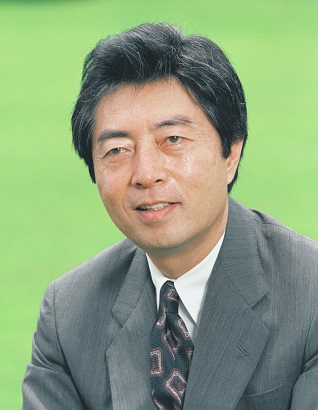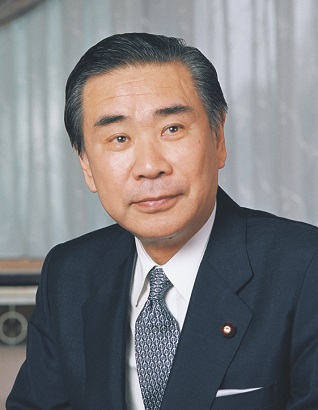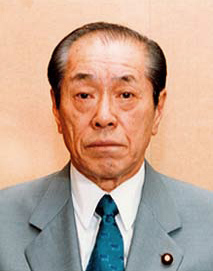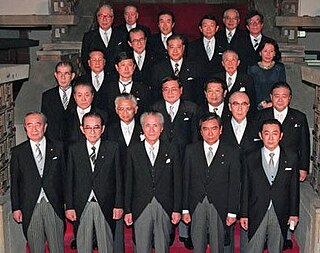
Politics of Japan are conducted in a framework of a dominant-party bicameral parliamentary constitutional monarchy, in which the Emperor is the head of state and the Prime Minister is the head of government and the head of the Cabinet, which directs the executive branch.

Masayoshi Ōhira was a Japanese politician who was Prime Minister of Japan from 1978 to 1980. Ōhira's term was cut short when he died in office; he remains the most recent Japanese Prime Minister to die in office.

Morihiro Hosokawa is a Japanese politician who was Prime Minister of Japan from 1993 to 1994, leading a coalition government which was the first non-Liberal Democratic Party (LDP) government of Japan since 1955. After successfully implementing various election and trade reforms, he stepped down from the role of Prime Minister in early 1994. He later ran unsuccessfully as a candidate for Governor of Tokyo in the February 2014 gubernatorial election as an independent supported by the Democratic Party of Japan. He has been, since 2005, the head of the Kumamoto-Hosokawa clan, one of the former noble families of Japan.

Tsutomu Hata was a Japanese politician who served as Prime Minister of Japan for nine weeks in 1994. He took over from Morihiro Hosokawa at the head of a coalition government. Shortly after he had been appointed Prime Minister, the Japanese Socialist Party left the government, leading to his early departure from office. He was a member of the lower house representing Nagano district #3. He was elected 14 times, retiring in 2012.

Tomiichi Murayama is a Japanese politician who served as Prime Minister of Japan from 1994 to 1996. He led the Japan Socialist Party, and was responsible for changing its name to the Social Democratic Party of Japan in 1996. Upon becoming Prime Minister, he was Japan's first socialist leader in nearly fifty years. He is most remembered today for his speech "On the occasion of the 50th anniversary of the War's end", in which he publicly apologised for Japan's past colonial rule and aggression. Of the ten living former prime ministers of Japan, he is currently the oldest living prime minister, following the death of Yasuhiro Nakasone on 29 November 2019. Murayama is also the only living former Japanese prime minister who was born in the Taishō era.

Ryutaro Hashimoto was a Japanese politician who served as the Prime Minister of Japan from 1996 to 1998. He was the leader of one of the largest factions within the ruling LDP through most of the 1990s and remained a powerful back-room player in Japanese politics until scandal forced him to resign his leadership position in 2004. Disgraced, he chose not to stand in the general election of 2005, and effectively retired from politics.

The New Party Sakigake, also known as the New Harbinger Party, was a political party in Japan that broke away from the Liberal Democratic Party (LDP) on 22 June 1993. The party was created by Masayoshi Takemura. The party was centrist, and had many reformist and even moderate ecological elements. The theoretical leader was Shusei Tanaka. Yukio Hatoyama and Naoto Kan also took part but later moved to the Democratic Party of Japan.

Hirohisa Fujii was a Japanese politician who was a member of the House of Councillors from 1977 to 1986, and of the House of Representatives from 1990 to 2012. He served two terms as Minister of Finance, and as Secretary General of the Liberal Party and the Democratic Party of Japan.
The Japan New Party was a Japanese political party that existed briefly from 1992 to 1994.

General elections were held in Japan on 18 July 1993 to elect the 511 members of the House of Representatives. The Liberal Democratic Party (LDP), which had been in power since 1955, lost their majority in the House. An eight-party coalition government was formed and headed by Morihiro Hosokawa, the leader of the Japan New Party (JNP). The election result was profoundly important to Japan's domestic and foreign affairs.

Hiromu Nonaka was a Japanese politician of the Liberal Democratic Party.
Events in the year 1993 in Japan. It corresponds to Heisei 5 (平成5年)) in the Japanese calendar.

The Murayama Cabinet governed Japan under the leadership of Prime Minister Tomiichi Murayama from 1994 until a 1995 Cabinet Reshuffle. Murayama was elected prime minister by the National Diet on 29 June 1994 after the threat of a no-confidence vote had brought down the previous minority Hata Cabinet. Murayama's and his cabinet's formal investiture by the Emperor took place one day later.

Wataru Kubo was a Japanese politician from the Social Democratic Party (SPD) and then from Democratic Party of Japan. He served as deputy prime minister and finance minister of Japan from 5 January 1996 to 7 November 1996.
Tatsuo Murayama was a Japanese politician who was a member of the Liberal Democratic Party (LDP) and finance minister for two times.

Shiga 2nd district is a single-member electoral district for the House of Representatives, the lower house of the Japanese National Diet, located in Eastern Shiga Prefecture.

Sohei Miyashita was a Japanese politician who served as Minister of Health and Welfare from 1998 to 1999, Director-General of the Environmental Agency from 1994 to 1995 and Director-General of the Defense Agency from 1991 to 1992.

The Hosokawa Cabinet governed Japan from August 9, 1993 to April 28, 1994 under the premiership of Morihiro Hosokawa. In Japan, his administration is generally referred to as a representative example of non-LDP and non-JCP Coalition.

The First Hashimoto Cabinet was formed in January 1996 under the leadership of Ryutaro Hashimoto, following the resignation of Tomiichi Murayama as Prime Minister of Japan and head of the coalition between the Liberal Democratic Party, Japan Socialist Party and New Party Sakigake. The smaller Socialist party relinquished the leadership of the government to the LDP, which was the largest party in the Diet and Hashimoto assumed the premiership, becoming the first LDP Prime Minister since August 1993.

Sadao Yamahana was Japanese politician who served as chairman of the Japan Socialist Party from January 1993 to September 1993.

















